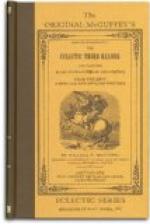I like to see a lit-tle dog,
And pat him on the head;
So pret-ti-ly he wags his tail
When-ev-er he is fed.
The First Reader was mostly in words of one syllable. In this book we find the story of the lame dog that, when cured, brought another lame dog to be doctored: of the kind boy who freed his caged bird; of the cruel boy who drowned the cat and pulled wings and legs from flies; of Peter Pindar the story teller, and the “snow dog” of Mount St. Bernard; of Mr. Post who adopted and reared Mary; of the boy who told a lie and repented after he was found out; of the chimney sweep who was tempted to steal a gold watch but put it back and was thereafter educated by its owner; of the whisky boy; and of the mischievous boy who played ghost and made another boy insane. Nearly every lesson has a moral clearly stated in formal didactic words at its close.
In the Second Reader we find the story of the idle boy who talked with the bees, dogs, and horses, and having found them all busy, reformed himself; of the kind girl who shared her cake with a dog and an old man; of the mischievous boys who tied the grass across the path and thus upset not only the milk-maid but the messenger running for a doctor to come to their father; of the wise lark who knew that the farmer’s grain would not be cut until he resolved to cut it himself; of the wild and ravenous bear that treed a boy and hung suspended by his boot; and of another bear that traveled as a passenger by night in a stage coach; of the quarrelsome cocks, pictured in a clearly English farm yard, that were both eaten up by the fox that had been brought in by the defeated cock; of the honest boy and the thief who was judiciously kicked by the horse that carried oranges in baskets; of George Washington and his historic hatchet and the mutilated cherry-tree; and of the garden that was planted with seeds in lines spelling Washington’s name which removed all doubt as to an intelligent Creator. There were also some lessons on such animals as beavers, whales, peacocks and lions.
[Favorite Selections]
The Third Reader will be remembered first because of the picture, on the cover, of Napoleon on his rearing charger. This book contained five selections from the Bible; Croly’s “Conflagration of the Ampitheatre at Rome;” “How a Fly Walks on the Ceiling;” “The Child’s Inquiry;” “How big was Alexander, Pa;” Irving’s “Description of Pompey’s Pillar;” Woodworth’s “Old Oaken Bucket;” Miss Gould’s “The Winter King;” and Scott’s “Bonaparte Crossing the Alps,” commencing “’Is the route practicable?’ said Bonaparte. ‘It is barely possible to pass,’ replied the engineer. ‘Let us set forward, then,’ said Napoleon.” The rearing steed facing a precipitous slope in the picture gave emphasis to the words. There were also in this reader several pieces about Indians and bears, which indicate that Dr. McGuffey never forgot the stories told at the fireside by his father of his adventures as an Indian scout and hunter.




